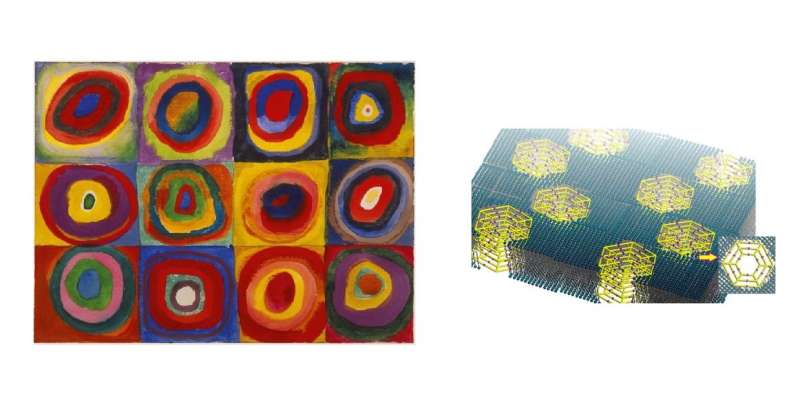May 22, 2018 feature
Giant molecules shaped like Kandinsky circles are toxic to MRSA bacteria

Nested structures are commonly found throughout nature and art, whether they be in the form of tree rings, Russian dolls, or Wassily Kandinsky's famous 1913 abstract painting Color Study: Squares with Concentric Circles. Now in a new study, chemists have constructed giant nested supramolecules or "supramolecular Kandinsky circles," some of which are more than 30,000 times heavier than a hydrogen atom. The scientists demonstrate that these supramolecules are highly toxic to methicillin-resistant Staphylococcus aureus (MRSA), potentially providing a new method for fighting these deadly pathogens.
The researchers, Heng Wang, Xiamin Qian, and their coauthors at universities in China and the US, have published a paper on the antimicrobial supramolecular Kandinsky circles in a recent issue of Nature Communications.
"Biomaterials based on supramolecular Kandinsky circles pave a new avenue to the development of a new generation of antibiotics with novel mechanisms through the formation of unprecedented transmembrane channels with distinct pore size," coauthor Xiaopeng Li at the University of South Florida told Phys.org.
Although called supramolecular Kandinsky circles, the supramolecules are composed of nested hexagons rather than circles, giving them the appearance of molecular spider webs. Constructing nested supramolecular structures has been a formidable challenge, which the researchers here address by using coordination-driven self-assembly. In this method, the supramolecules are composed of coordination complexes, which consist of a central metal ion surrounded by organic ligands that branch out to allow for the formation of multiple 2-D layers of nested hexagons.
When observing these supramolecular structures with various imaging technologies, the researchers discovered that they have a strong tendency to curl up into tubular nanostructures. Partly for this reason, along with results from previous research, the scientists suspected that the new supramolecules may have antimicrobial properties. They tested the supramolecules on two types of bacteria, MRSA and E. coli, and found that the supramolecules were highly toxic to MRSA but unable to inhibit E. coli. This is likely due to the difference in the cell walls: E. coli, which is Gram-negative, has both an inner and an outer membrane, while MRSA, which is Gram-positive, has only an inner membrane and so is more susceptible to the supramolecules.
Experiments showed that the antibacterial mechanism of the supramolecules arises from the nested hexagon structure, which curls into a tube, penetrates the inner membrane, and provides a channel through which the bacterial cell's cytoplasm leaks out. After a few hours, the leaking of the cytoplasmic contents results in cell death. On the other hand, the supramolecules exhibit negligible toxicity to red blood cells, which the researchers attribute to a weaker electrostatic attraction between the surfaces of the supramolecules and these cells, compared to the surface of the supramolecules and the bacteria.
In the future, the supramolecular Kandinsky circles may provide a new defensive strategy against MRSA, with potential advantages that may include preventing the bacteria from developing antibiotic resistance, as well as reducing the toxicity to human cells. This is because the supramolecules have low minimum inhibitory concentrations (MICs), meaning less is needed to inhibit bacterial growth, compared to some other antimicrobial agents. One possibility is to combine the supramolecules with existing antibiotics in order to realize these advantages. Before then, the researchers plan to make further improvements on the supramolecules.
"We will increase the water solubility of the Kandinsky circles to further enhance their antibacterial activity," Li said.
More information: More information: Heng Wang, Xiaomin Qian, et al. "Supramolecular Kandinsky circles with high antibacterial activity." Nature Communications. DOI: 10.1038/s41467-018-04247-z
Journal information: Nature Communications
© 2018 Phys.org



















